COPYRIGHT 2010 DICK NEWELL
 |
 |
Learning to read the tracks and understand the gaits of birds can be pretty straight forward for those who have studied Mark Elbroch’s text on Bird Tracks and Sign. He suggests dividing all bird tracks into one of five classifications based on the number of digits showing in the substrate, whether they point forward or backward and, if they are webbed between the digits. Once you determine the classification look at the sequence of the tracks to determine if the bird normally hops or walks and then get a measurement of the actual track and you are well on your way to making an identification. First lets talk about measuring bird tracks and numbering the digits and then we will look at each of the various classifications.

When you measure bird tracks you want to include their claws in the measurement. The hallux, the toe or more correctly the digit pointing to the rear is always #1 (whether the digit shows or not), then number them going around the inside and going forward. If there are two digits to the rear, the inside-rear digit will be #1 and the rear-outside digit will be #4. We will talk more about this in each individual classification.
First let’s learn the groups or classes and how to measure each of them.
First let’s learn the groups or classes and how to measure each of them.


 |
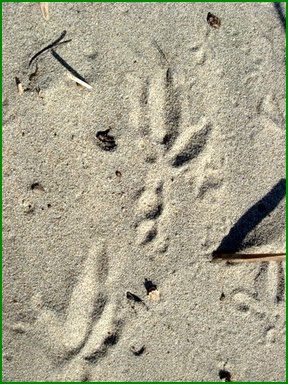
1) Classic bird tracks. These tracks will show three digits pointing forward and one, the hallux, pointing to the rear. This group of birds includes passerines which are tree dwelling birds or song birds as well as egrets, eagles, hawks, crows, ravens, towhees and many others. This is by far the most common group. Measure these tracks from the tip of the claw on digit #1 to the tip of the claw on digit #3 to determine the overall length and from the tip of digit #2 to the tip of #4 for the width.
2) Game bird tracks. These tracks will show three digits forward. A stub or small portion of the rear digit (hallux) may show but it is not reliable and this is what separates this class from the first one. This category includes shorebirds such as sandpipers and stilts, rails, coots, plovers and pheasant, quail, turkeys, etc. Since the hallux does not completely show, you measure these tracks from the base of the metatarsal pad to the top of the claw on digit #3 to get the overall length and from the tip of #2 to the tip of #4 for the width.
3) Webbed or palmate tracks. These are tracks that are webbed between digits #2, #3 and #4 but don’t usually show a hallux. This class includes ducks, loons, geese, avocets, gulls, terns and more. Like game birds, you measure these from the bottom of the metatarsal pad to the tip of digit #3 since the hallux is greatly reduced or doesn’t show.
4) Totipalmate tracks. This class is similar to the previous class except they will show the hallux and they are webbed between each of the digits including the hallux. Locally there are only pelicans and cormorants in this class. Even though it’s a webbed track, the hallux shows so measure its length by going from the claw on #1 to the tip of the claw on #4 which is the longest digit.
5) Zygodactyl tracks. Zygodactyl is defined as having four toes arranged in two opposing pairs, two in front and two to the rear. This class includes owls, parrots, ospreys, woodpeckers, flickers and roadrunners. You measure the length of these tracks at their longest potential by going straight up the length of the track regardless if that is on the inside or outside.
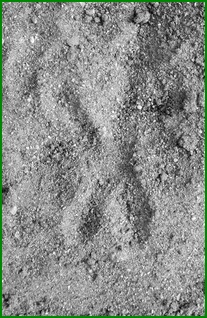
Owls however are the exception as the straight part of their track is on the inside and the two angled digits are on the outside. In the case of the Great Horned Owl digit #4 might even point out at a 90 degree angle as shown here.
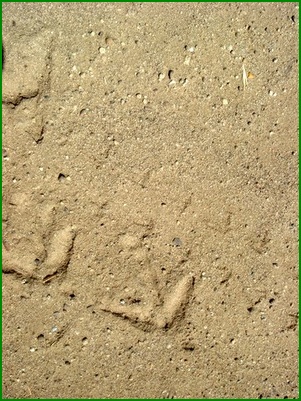
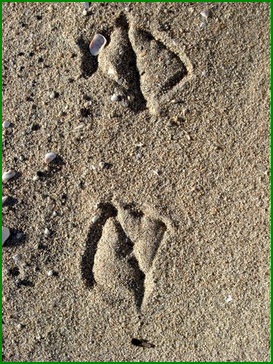
Remember we are classifying tracks based on what is observed on the ground and not what the bird actually has, i.e., they may have some webbing between the digits that doesn’t show in the track and so we must treat it as if the webbing doesn’t exist. If you suspect webbing but don’t observe it in the track you can always look to see if the outer digits point toward the center as they will on a webbed foot.
Next let’s talk about the four common bird gaits as shown in the patterns that we frequently see.
Next let’s talk about the four common bird gaits as shown in the patterns that we frequently see.
 |
1) Walking. A walk is the preferred gait for ground dwelling birds as well as for those with a reduced hallux. The track will show one foot in front of the other and they will be closely spaced. A few of the birds that use this gait include pigeons, ducks, raptors, crows and ravens.
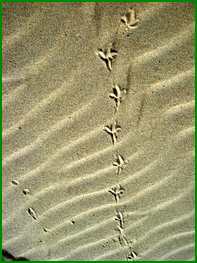
2) Running. We will often see this gait being used by ground dwelling birds. Their stride will frequently be 2 to 5 times the length of the track and it will show as one track placed directly in front of the next but with a much greater space between the tracks than seen in the walk. You can document the change in the pace (walk to a run) by measuring the distance between the tracks. This group includes towhees and many other ground dwellers and often crows and ravens. Remember that some birds such as crows and ravens can either walk, run or hop.
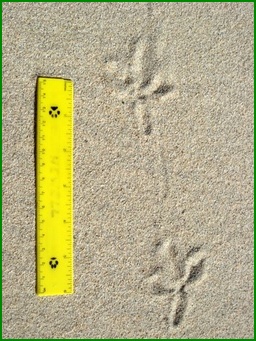
3) Hopping. These tracks are paired or placed side by side. This is the normal pattern for tree dwelling birds and many other passerines such as finches.
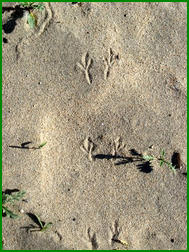
4) Skipping. Tracks are in pairs but they are not quite side by side as each foot lands independently and in front of the other. This is most often done by sparrows or other perching birds and it illustrates an increased level of speed.
Finally, if we know a little more about the habits of individual species it will help to either confirm our identifications or to aid us in making them. For example if you know what steps precede a take-off you might be better able to identify the bird by its track. Ravens, coots and a few others require a running or hopping start while others such as crows, doves and most game birds can take off directly from a standing start. Take a closer look at the last track a bird leaves before its take-off to see if you can observe that the track is deeper in the front than preceding ones were.
Combine what you see in the track using these skills, compare them with known measurements of your local birds and consider the environmental aspects and you will have your identification. A comprehensive list of bird track dimensions is displayed on the inside covers of Bird Track & Sign and that data is sorted by track type and size. A brief sample from that text follows:
Combine what you see in the track using these skills, compare them with known measurements of your local birds and consider the environmental aspects and you will have your identification. A comprehensive list of bird track dimensions is displayed on the inside covers of Bird Track & Sign and that data is sorted by track type and size. A brief sample from that text follows:
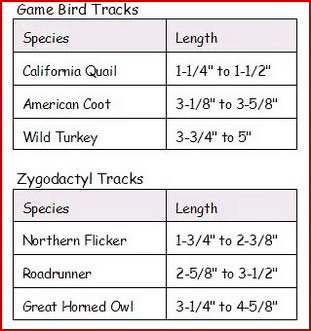
© Mark Elbroch
 |
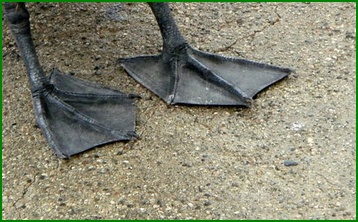
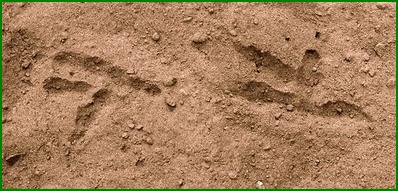
Roadrunners and woodpeckers such as the Northern Flicker have two digits pointing forward and two to the rear as shown in this roadrunner's right-foot track. For all but owls these tracks will look like the letter (K) with the straight bar being on the outside of each track and the angled (< ) digits pointing towards the inside of the track. These tracks are longer in the front portion than in the rear making it easy to determine the direction of travel.

